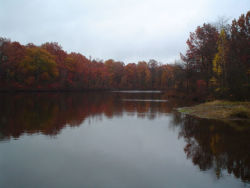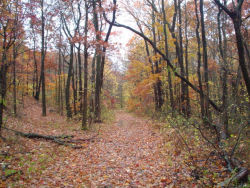Long Pond Park
Long Pond Park
As natural resources dwindle on Staten Island, our parks are becoming ever more important as oases for plants and animals. Long Pond Park provides an important stop on the Atlantic flyway for migrating birds as well as being a place of respite and recreation for many people. This unique area is composed of a combination of wetland and woodland, including naturally formed Long Pond.
Long Pond is one of the most pristine ponds in the New York City area. Located 65 feet above sea level, it is fed completely from underground springs. Due to its elevation, the pond does not receive surface water, thus it resists pollutants that often flow into bodies of water from surface run-off. With its special level of purity, the pond is a vital habitat supporting many species of animals.
Long Pond’s history stretches back for thousands of years, beginning with the Wisconsin Ice Sheet. Twelve to fifteen thousand years ago, a huge sheet of ice blanketed the area, hundreds of feet thick. The pressure of the ice caused depressions in sections that had weak underlying rock layers. As the ice receded, these sunken areas formed wetlands such as Long Pond and Pam’s Pond. As a result, areas of stronger underlying rock were left above sea level. This topographical feature, known as “knob and kettleterrain,” can be seen throughout much of Staten Island. The extreme southern and southeastern portions of the island were not covered by the Wisconsin Ice Sheet and therefore do not exhibit this type of terrain.
Long Pond and other bodies of water in the park have been incorporated into the Bluebelt water drainage system by the New York City Department of Environmental Protection. Encompassing several parcels of state-protected wetlands on the island’s south shore, the Bluebelt system was specifically designed to provide storm water drainage for the neighboring communities. Mature beech, oak and hickory woodlands provide much of the foliage in the park, with many of the trees over sixty years old. They help to support an understory layer of spicebush (Lindera benzoin), blueberry (Vaccinium spp.) and many herbaceous plants.
The natural appearance of Long Pond Park belies its history of use as living space and farmland by Native Americans and European colonists. Its association with Parks dates back to 1931, when a 3.5-acre parcel called Cozzens Woods was purchased by the city for use as a playground. Remnants of the old playground still stand in the park woodlands. In 1975, the South Richmond Special Development District Zoning Plan designated 70 acres adjoining Long Pond as open space. During the 1980s, Long Pond and 104 surrounding acres were designated protected freshwater wetlands by the New York State Department of Environmental Conservation. Parks acquired this property, in its full entirety, with the purchase of an additional parcel of 19 acres in 2000. Mayor Rudolph W. Giuliani funded over $4 million for this, after local environmental groups lobbied to protect this important natural habitat from developers. Today, Long Pond Park, located at Hylan Boulevard and Richard Avenue in one of the least densely populated areas of New York City, serves as a living classroom for young and old alike, providing a recreational environment hearkening back to the Island’s rural past.
Check out your park's Vital Signs
Clean & Safe
Green & Resilient
Empowered & Engaged Users
Share your feedback or learn more about how this park is part of a
Vital Park System



